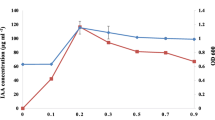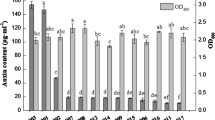Abstract
Phytohormones from rhizobacterial origin have been linked to their phytostimulation potential. However, while studying the efficacy of plant growth promoting bacteria, focus has always been on a single hormone. The role of plant hormones often overlay and they mutually modulate their effect. In current study focus was on the role of two hormones (cytokinins and indole acetic acid) in phytostimulation by rhizobacteria. Endogenous rhizosphere bacteria were isolated and screened for the presence of phytohormones. Bacterial strains from three different genera (Pseudomonas, Bacillus and Azospirillum) were screened positive for cytokinins and IAA. Phytohormones were simultaneously determined in SPE purified bacterial extract by ultra performance liquid chromatography (UPLC) coupled to a tandem mass spectrometer through electrospray interface. Cytokinins and IAA were determined in positive and negative mode, respectively with MRM scan. Zeatin, zeatin riboside and dihydrozeatin riboside were detected and quantified in the selected strains. Significant positive correlation between cytokinins and IAA in bacterial culture and plant endogenous hormones (r = 0.933 and r = 0.983; P = 0.01, respectively) was observed. However, strains with high IAA to cytokinins ratio could hardly enhance in-planta cytokinins, indicating antagonistic relation between the two hormones. Significant correlation of cytokinin with shoot length (r = 0.797; P = 0.01), fresh weight (r = 0.685; P = 0.01) and dry weight (r = 0.704; P = 0.01) was reported under axenic conditions. Bacterial IAA was correlated negatively to root length (r = 0.853; P = 0.01) and positively correlated to the number of roots (r = 0.964; P = 0.01). In natural conditions maximum increase in spike length (33%), number of tillers (71%) and weight of seeds (39%) was documented at final harvest in bacterially inoculated plants.


Similar content being viewed by others
References
Akiyoshi DE, Regier DA, Gordon MP (1987) Cytokinin production by Agrobacterium and Pseudomonas spp. J Bacteriol 169:4242–4248
Ali B, Sabri AN, Ljung K, Hasnain S (2009a) Auxin production by plant associated bacteria: impact on endogenous IAA content and growth of Triticum aestivum L. Lett Appl Microbiol 48:542–547
Ali B, Sabri AN, Ljung K, Hasnain S (2009b) Quantification of indole-3-acetic acid from plant associated Bacillus spp. and their phytostimulatory effect on Vigna radiata (L.). World J Microbiol Biotechnol 25:519–526
Antoun H, Beauchamp CJ, Goussard N, Chabot R, Lalande R (1998) Potential of Rhizobium and Bradyrhizobium species as plant growth promoting rhizobacteria on non-legumes: effect on radishes (Raphanus sativus L.). Plant Soil 204:57–67
Arkhipova T, Melentiev A, Veselov S, Kudoyarova G (2004) Effect of cytokinin-producing microorganisms on resistance of lettuce plant to drought and toxic metal. Acta Physiol Plantarum 26:275
Arkhipova TN, Veselov SU, Melentiev AI, Martynenko EV, Kudoyarova GR (2005) Ability of bacterium Bacillus subtilis to produce cytokinins and to influence the growth and endogenous hormone content of lettuce plants. Plant Soil 272:201–209
Arkhipova TN, Veselov SY, Melent’ev AI, Martynenko EV, Kudoyarova GR (2006) Comparison of effects of bacterial strains differing in their ability to synthesize cytokinins on growth and cytokinin content in wheat plants. Russ J Plant Physiol 53:507–513
Arkhipova TN, Prinsen E, Veselov SU, Martinenko EV, Melentiev AI, Kudoyarova GR (2007) Cytokinin producing bacteria enhance plant growth in drying soil. Plant Soil 292:305–315
Aslantas R, Cakmakci R, Sahin F (2007) Effect of plant growth promoting rhizobacteria on young apple tree growth and fruit yield under orchard conditions. Sci Hortic 111:371–377
Barazani OZ, Friedman J (1999) Is IAA the major root growth factor secreted from plant-growth-mediating bacteria? J Chem Ecol 25:2397–2406
Belimov AA, Dodd IC, Hontzeas N, Theobald JC, Safronova VI, Davies WJ (2009) Rhizosphere bacteria containing 1-aminocyclopropane-1-carboxylate deaminase increase yield of plants grown in drying soil via both local and systemic hormone signalling. New Phytol 181:413–423
Benizri E, Courtade A, Picard C, Guckert A (1998) Role of maize root exudates in the production of auxins by Pseudomonas fluorescens M. 3.1. Soil Biol Biochem 30:1481–1484
Carabelli M et al (2007) Canopy shade causes a rapid and transient arrest in leaf development through auxin-induced cytokinin oxidase activity. Genes Dev 21:1863–1868
Dworkin M, Foster JW (1958) Experiments with some microorganisms which utilize ethane and hydrogen. J Bacteriol 75:592–603
Fischer SE, Fischer SI, Magris S, Mori GB (2007) Isolation and characterization of bacteria from the rhizosphere of wheat. World J Microbiol Biotechnol 23:895–903
Ghosh S, Sengupta C, Maiti TK, Basu PS (2008) Production of 3-indolylacetic acid in root nodules and culture by a Rhizobium species isolated from root nodules of the leguminous pulse Phaseolus mungo. Folia Microbiol 53:351–355
Hasnain S, Thomas CM (1996) Two related rolling circle replication plasmids from salt-tolerant bacteria. Plasmid 36:191–199
Hussain A, Hasnain S (2009) Cytokinin production by some bacteria: its impact on cell division in cucumber cotyledons. Afr J Microbiol Res 3:704–712
Hussain A, Hasnain S (2010) Phytostimulation and biofertilization in wheat by cyanobacteria. J Ind Microbiol Biotechnol 38:85–92
Hussain A, Krischke M, Roitsch T, Hasnain S (2010) Rapid determination of cytokinins and auxin in Cyanobacteria. Curr Microbiol 61:361–369
Idris ESE, Iglesias DJ, Talon M, Borriss R (2007) Tryptophan-dependent production of indole-3-acetic acid (IAA) affects level of plant growth promotion by Bacillus amyloliquefaciens FZB42. Mol Plant Microbe Int 20:619–626
Johnson BJ (1994) Influence of plant-growth regulators and mowing on 2 bermuda grasses. Agron J 86:805–810
Joo GJ, Kim YM, Lee IJ, Song KS, Rhee IK (2004) Growth promotion of red pepper plug seedlings and the production of gibberellins by Bacillus cereus, Bacillus macroides and Bacillus pumilus. Biotechnol Lett 26:487–491
Karadeniz A, Topcuoglu SF, Inan S (2006) Auxin, gibberellin, cytokinin and abscisic acid production in some bacteria. World J Microbiol Biotechnol 22:1061–1064
Karthikeyan N, Prasanna R, Sood A, Jaiswal P, Nayak S, Kaushik BD (2009) Physiological characterization and electron microscopic investigation of cyanobacteria associated with wheat rhizosphere. Folia Microbiol 54:43–51
Khalid A, Arshad M, Zahir ZA (2004) Screening plant growth-promoting rhizobacteria for improving growth and yield of wheat. J Appl Microbiol 96:473–480
Lata H, Li XC, Silva B, Moraes RM, Halda-Alija L (2006) Identification of IAA-producing endophytic bacteria from micropropagated Echinacea plants using 16S rRNA sequencing. Plant Cell Tissue Org 85:353–359
Long HH, Schmidt DD, Baldwin IT (2008) Native bacterial endophytes promote host growth in a species-specific manner; phytohormone manipulations do not result in common growth responses. PLoS ONE 3:e2702
McLellan CA, Turbyville TJ, Wijeratne EM, Kerschen A, Vierling E, Queitsch C, Whitesell L, Gunatilaka AA (2007) A rhizosphere fungus enhances Arabidopsis thermotolerance through production of an HSP90 inhibitor. Plant Physiol 145:174–182
Penrose DM, Glick BR (2003) Methods for isolating and characterizing ACC deaminase-containing plant growth-promoting rhizobacteria. Physiol Plantarum 118:10–15
Pérez-Miranda S, Cabirol N, George-Téllez R, Zamudio-Rivera LS, Fernández FJ (2007) O-CAS, a fast and universal method for siderophore detection. Microbiol Methods 70:127–131
Pertry I et al (2009) Identification of Rhodococcus fascians cytokinins and their modus operandi to reshape the plant. Proc Natl Acad Sci 106:929–934
Pikovskaya RI (1948) Mobilization of phosphorus in soil in connection with vital activity of some microbial species. Microbiol 17:362–370
Ramos B, Garcia JAL, Probanza A, Barrientos ML, Manero FJG (2003) Alterations in the rhizobacterial community associated with European alder growth when inoculated with PGPR strain Bacillus licheniformis. Environ Exp Bot 49:61–68
Remans R et al (2008) Physiological and genetic analysis of root responsiveness to auxin-producing plant growth-promoting bacteria in common bean (Phaseolus vulgaris L.). Plant Soil 302:149–161
Ryu CM, Hu CH, Locy RD, Kloepper JW (2005) Study of mechanisms for plant growth promotion elicited by rhizobacteria in Arabidopsis thaliana. Plant Soil 268:285–292
Spaepen S, Dobbelaere S, Croonenborghs A, Vanderleyden J (2008) Effects of Azospirillum brasilense indole-3-acetic acid production on inoculated wheat plants. Plant Soil 312:15–23
Teale WD, Paponov IA, Palme K (2006) Auxin in action: signaling, transport and the control of plant growth and development. Nat Rev Mol Cell Biol 7:847–859
Tien TM, Gaskins MH, Hubbell DH (1979) Plant growth substances produced by Azospirillum brasilense and their effect on the growth of pearl millet (Pennisetum americanum L.). Appl Environ Microbiol 37:1016–1024
Tsavkelova EA, Klimova SY, Cherdyntseva TA, Netrusov AI (2006) Microbial producers of plant growth stimulators and their practical use: a review. Appl Biochem Microbiol 42:117–126
Tzfira T, Jensen CS, Wang WX, Zuker A, Vinocur B, Altman A, Vainstein A (1997) Transgenic Populus tremula: a step-by-step protocol for its Agrobacterium-mediated transformation. Plant Mol Biol Rep 15:219–235
Acknowledgments
Higher Education commission of Pakistan is acknowledged for providing financial support to the visit of Mr. Anwar Hussain to Wurzburg University Germany. Prof. Dr. Thomas Roitsch and Dr. Markus Krischke, Department of Pharmaceutical Biology, Wurzburg University, Germany, are acknowledged for providing the laboratory facilities and help in phytohormones determination.
Author information
Authors and Affiliations
Corresponding author
Rights and permissions
About this article
Cite this article
Hussain, A., Hasnain, S. Interactions of bacterial cytokinins and IAA in the rhizosphere may alter phytostimulatory efficiency of rhizobacteria. World J Microbiol Biotechnol 27, 2645–2654 (2011). https://doi.org/10.1007/s11274-011-0738-y
Received:
Accepted:
Published:
Issue Date:
DOI: https://doi.org/10.1007/s11274-011-0738-y




